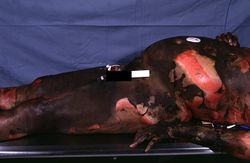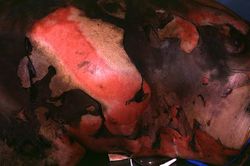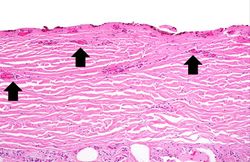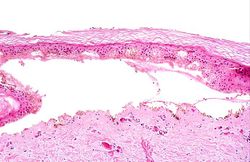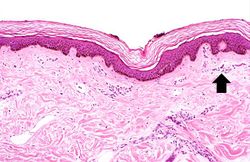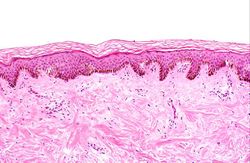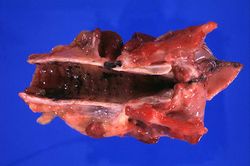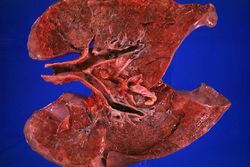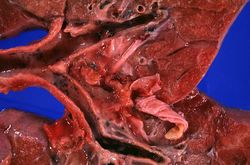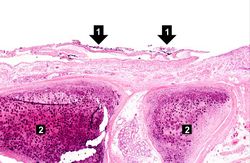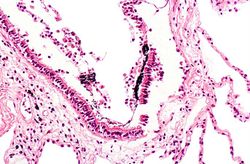Difference between revisions of "IPLab:Lab 12:Burns"
Seung Park (talk | contribs) |
Seung Park (talk | contribs) |
||
| Line 21: | Line 21: | ||
File:IPLab12Burns13.jpg|The damage to the tracheal epithelium and the black carbonaceous material is present down to the level of the terminal bronchioles. | File:IPLab12Burns13.jpg|The damage to the tracheal epithelium and the black carbonaceous material is present down to the level of the terminal bronchioles. | ||
</gallery> | </gallery> | ||
| + | |||
| + | == Study Questions == | ||
| + | * <spoiler text="What was the proximate cause of death in this patient? What other factors played a role in this patient's demise?">This patient died of respiratory failure. The gross and microscopic evidence of smoke inhalation and burn injury to the nose, throat and lungs are indicative of severe lung injury. Inhalation injury is seen in over 80% of patients with a burn size of 85% or more of the total body surface area. Carbon monoxide poisoning also contributes to the early death in inhalation injury. | ||
| + | |||
| + | An additional factor that likely would have lead to death of this patient was the severity and the extent of the body surface area that was burned. Clinical management of a patient with burns this severe would be very difficult. Shock and sepsis are common problems in these patients.</spoiler> | ||
| + | * <spoiler text="What is the significance of the fatty liver and the blood alcohol level noted in this patient?">The fatty liver and the elevated blood alcohol level indicate that this patient was severely incapacitated by alcohol prior to the fire. The patient was likely in an alcoholic stupor when the fire broke out and could not escape.</spoiler> | ||
{{IPLab 12}} | {{IPLab 12}} | ||
[[Category: IPLab:Lab 12]] | [[Category: IPLab:Lab 12]] | ||
Revision as of 16:22, 21 August 2013
Clinical Summary[edit]
This 45-year-old back female was involved in a house fire which killed her husband. Upon admission to a local emergency room she was found to have approximately 80% body surface area burns including 1st, 2nd, and 3rd degree burns. Burns were most severe around the head and neck. The patient was intubated and transferred to a tertiary care center. Upon arrival, the patient had a blood pressure of 71/25 mmHg, a heart rate of 121, and was responsive to deep pain but had few spontaneous movements. Both eyes were swollen shut, her nasal hairs were singed, and carbonaceous deposits were present in her nares, throat, and posterior pharynx. Despite aggressive fluid resuscitation and ventilatory support, she remained hypotensive, and became progressively hypoxemic and hypercapnic until she died approximately eight hours after the fire.
Autopsy Findings[edit]
The degree and severity of body surface burns were documented. Carbonaceous material was noted in the throat and posterior pharynx as well as in the trachea and main stem bronchi. The liver was soft, yellow and greasy. Results of premortem blood work showed a blood alcohol level of 147 mg/dL.
Images[edit]
Study Questions[edit]
| |||||
A blood alcohol level over 100 mg/dL is considered legally drunk.
In alcoholics, aspiration pneumonia is common--bacteria enter the lung via aspiration of gastric contents.
